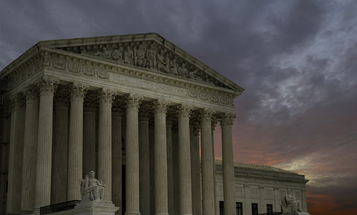
To Save Democracy We Must Remake the Courts
The Right’s latest attempt to ram through a Supreme Court justice is part of a larger strategy to entrench minority rule. For democracy to survive, we need to reboot and reimagine the judiciary.

Just a few days after Supreme Court Justice Ruth Bader Ginsburg’s passing, President Trump moved quickly to appoint a replacement. If his appointment goes through, the resulting 6-3 far-right majority on the Supreme Court would have the power to rule on a range of issues that impact our lives.
The timing is crucial and certainly not innocent.
With voting already underway in the 2020 election, a rushed appointment and confirmation would further collapse the legitimacy of the Supreme Court. A growing number of moderates are warning that should he ram through an appointment, this fact, plus the deliberate blockade of President Obama’s appointment of Merrick Garland in 2016, would justify progressives in adding seats to the Supreme Court to restore balance.
It is critical that our democracy reform agenda also consider how to reform the judiciary.
More broadly, the firestorm over Justice Ginsburg’s replacement is a reminder of how the modern Supreme Court has too much power in the first place. It is critical that our democracy reform agenda also consider how to reform the judiciary.
First, courts have too much power to radically remake our social and economic life.
And the Supreme Court is designed to wield exceptional power in peoples’ lives—and further enshrine inequitable power structures. Here’s what’s at stake: gutting the Affordable Care Act (in the middle of a deadly pandemic); eradicating wins for reproductive justice; rolling back anti-discrimination protections for LGBTQ and Black and brown Americans; and further shielding police departments and immigration officials from accountability for racist state-sponsored violence against people of color. This sheer concentration of power without sufficient accountability and checks is a threat to democracy—and to the ability of our communities to thrive.
Second, courts actively threaten democracy by skewing political power towards the wealthy and corporations, away from working-class communities and Black and brown communities.
This is about who has power in our country. We are already living with the fallout of such decisions, such as union-busting judicial rulings that dismantle organized labor, and the Supreme Court’s warped reading of the First Amendment to concentrate corporate power and hamstring vital economic regulations. Our courts have increasingly intervened to needlessly dismantle the Voting Rights Act, letting politicians rig district lines; and permitting dark money to control our politics through the greenlighting of extreme gerrymandering. In recent weeks, courts across the country have gone out of their way to validate policies blatantly designed to suppress the votes of Black and brown people.
This is a concerted power grab strategy by the Right.
These moves together amount to an attempt to election-proof control[.]
They rig and skew elections to win legislative power in states and in the Senate; use that leverage to pack the courts with judges who will rule favorably to further distort the electoral process, block rival legislation, and secure power. These moves together amount to an attempt to election-proof control, reserving for the Right the ultimate trump card that would block legislative and electoral shifts needed to rebalance democratic fairness and advance progressive policies.
Therefore, if we are to defend and rebuild our democracy, alongside investing in and supporting organizing and movements across the country, we need to advance structural reforms—including reforming the courts themselves.
Congress is already considering the For the People Act, a landmark bill that would restore and expand voting rights, stop the flow of big money in politics, advance fair redistricting measures, and much more. These measures should be passed first and foremost in any new administration.
But that’s not all. We should consider sweeping changes to reform the judiciary.
We should consider sweeping changes to reform the judiciary.
It’s time for a judiciary that is much more reflective of our country. We need more Black and brown judges, more women judges, more judges who have had lived experiences of inequity, discrimination, and struggle. Imagine what a Court filled with justices with direct experience of systemic racism, of gender and LGBTQ discrimination, of the struggle against homelessness and hunger and unstable health care coverage, would look like, and what such a Court would do.
We need to establish fixed and staggered term limits for justices and expand the size of the Supreme Court.
These cannot be lifetime positions, and we should rethink our model of how the Supreme Court functions. We need to establish fixed and staggered term limits for justices. Similarly, we should expand the size of the Supreme Court. The size of the Court has been adjusted repeatedly in our history by act of Congress. In a world where the Court possesses such vast power over the fates of so many Americans, it is no longer tenable to restrict its membership to 9 people, the majority of whom will have been appointed by presidents who failed to secure the support of the majority of the electorate. We need a Court that is connected to the democratic public, and more reflective of the lived experience of Black and brown and working-class Americans. With a larger court, we could further reduce the arbitrary power of any one “swing” justice, by moving to a model akin to Circuit Courts of Appeals, where cases are heard by randomly drawn smaller panels, with an option to appeal to the larger full Circuit.
We should pay closer attention to state courts.
Finally, we should pay closer attention to state courts. State courts have tremendous power over the course of public policy and impacts on communities, especially in an era of federal deadlock. We have already seen brazen attempts to pack and rig courts in Georgia and Arizona, to lock in partisan advantage in the face of demographic shifts and renewed Black and brown organizing and mobilization that threatens long-standing GOP dominance in these states. In states where state supreme court judges are elected, we see a troubling flow of corporate campaign dollars to swing these elections—and then see how these courts undermine the democratically-sanctioned efforts of elected officials to pursue needed reforms. Reforms to state courts should also address these challenges, building a more reflective and responsive judiciary attuned to the needs of communities.
We are fighting in this moment for the basic idea of a multiracial, inclusive democracy where Black and brown communities have the safety, security, and freedom to thrive. That battle requires structural change to dismantle our racialized systems of violence, economic inequality, and unequal political voice. Building a better judiciary, one that enables, rather than frustrates, the process of democratic inclusion and responsiveness, is part of a larger, comprehensive set of changes we so desperately need. With the Senate rushing to fill the Supreme Court vacancy as fast as it can, now is the time to not only push back on this scramble but to begin this critical reimagining of our judicial system.




